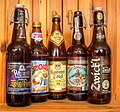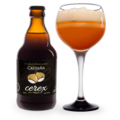Portal:Beer
Introduction

Beer is an alcoholic beverage produced by the brewing and fermentation of starches from cereal grain—most commonly malted barley, although wheat, maize (corn), rice, and oats are also used. The grain is mashed to convert starch in the grain to sugars, which dissolve in water to form wort. Fermentation of the wort by yeast produces ethanol and carbonation in the beer. Beer is one of the oldest alcoholic drinks in the world, the most widely consumed, and the third most popular drink after water and tea. Most modern beer is brewed with hops, which add bitterness and other flavours and act as a natural preservative and stabilising agent. Other flavouring agents, such as gruit, herbs, or fruits, may be included or used instead of hops. In commercial brewing, natural carbonation is often replaced with forced carbonation.
Beer is distributed in bottles and cans, and is commonly available on draught in pubs and bars. The brewing industry is a global business, consisting of several dominant multinational companies and many thousands of smaller producers ranging from brewpubs to regional breweries. The strength of modern beer is usually around 4% to 6% alcohol by volume (ABV).
Some of the earliest writings mention the production and distribution of beer: the Code of Hammurabi included laws regulating it, while "The Hymn to Ninkasi", a prayer to the Mesopotamian goddess of beer, contains a recipe for it. Beer forms part of the culture of many nations and is associated with social traditions such as beer festivals, as well as activities like pub crawling, pub quizzes, and pub games. (Full article...)
Selected articles -
The Pabst Brewing Company (/ˈpæpst/) is an American company that dates its origins to a brewing company founded in 1844 by Jacob Best and was, by 1889, named after Frederick Pabst. It outsources the brewing of over two dozen brands of beer and malt liquor. These include its own flagship Pabst Blue Ribbon, as well as brands from many defunct breweries.
Pabst is headquartered in San Antonio, Texas. On March 16, 2021, it was announced that Blue Ribbon Partners, an investment platform led by American beer and beverage entrepreneur Eugene Kashper, owns 100% of Pabst Brewing Company. Blue Ribbon Partners is focused on beer and beverages in the US. Prior to current ownership, on November 13, 2014, Pabst announced that it had completed its sale to Blue Ribbon Intermediate Holdings, LLC, which was a partnership between Eugene Kashper and TSG Consumer Partners, a San Francisco–based private equity firm. Prior reports suggested the price agreed upon was around $700 million. (Full article...)
Selected brand -
Stones Bitter is a beer manufactured and distributed in the United Kingdom by the North American brewer Molson Coors. It is a bitter with a straw-golden hue. Stones Bitter was first brewed in 1948 by William Stones Ltd at the Cannon Brewery in Sheffield. It was designed for the local steelworkers and became successful in its local area, becoming one of Sheffield's best known products.
Bass Charrington acquired William Stones in 1968, and began to heavily promote the keg variant of Stones Bitter, which eventually became the highest selling bitter in the country. In the 1990s the ABV of Stones was gradually reduced, and, as ale sales declined, Stones reverted from a national into a regional brand. Following the closure of the Cannon Brewery, Stones has been brewed at a number of different breweries. When Bass exited its brewing business, Stones became a Coors brand (later Molson Coors). (Full article...)
Selected biography -
Michael Thomas Bass (23 July 1760 – 9 March 1827) was a brewer of Burton-on-Trent, England, who considerably developed the Bass brewing company. (Full article...)
Did you know (auto-generated) -

- ... that the patu clubs on the New Zealand threepence were compared to bottles of ginger beer?
- ... that Pope Pius IX gave the monks of Saint Vincent Archabbey permission to brew Saint Vincent Beer?
- ... that 100 beerhouses were licensed in Brighton (population 40,000) in the first week after the Beerhouse Act 1830 was enacted?
- ... that brewer Sophie de Ronde is allergic to most beer?
- ... that the offices of Hamm's Brewery in Saint Paul, Minnesota, were built on the site of the city's third cathedral?
- ... that Ein Samiya, which provides the water for Taybeh, the first beer brewed in Palestine, was depopulated in 2023 after harassment by neighboring Israeli settlers?
Selected brewery -
Rogue Ales is a brewery founded in 1988 in Ashland, Oregon. Rogue has pub locations in Oregon. (Full article...)
Selected image -

General images
Beer topics
Categories
Selected quote -
| “ | Well ya see, Norm, it's like this... A herd of buffalo can only move as fast as the slowest buffalo, and when the herd is hunted, it is the slowest and weakest ones at the back that are killed first. This natural selection is good for the herd as a whole, because the general speed and health of the whole group keeps improving by the regular killing of the weakest members. In much the same way, the human brain can only operate as fast as the slowest brain cells. Excessive intake of alcohol, as we know, kills brain cells, but naturally it attacks the slowest and weakest brain cells first. In this way, regular consumption of beer eliminates the weaker brain cells, making the brain a faster and more efficient machine. That's why you always feel smarter after a few beers. | ” |
The Buffalo Theory as explained on an episode of Cheers by Cliff Clavin to his drinking buddy, Norm Peterson |
Related portals
Beer lists
Things you can do
This list is transcluded from the tasks list page, to edit, click here
This is a list of single time tasks that need action. Once you have completed them, please remove them from the list.
 |
Here are some tasks awaiting attention:
|
WikiProjects

WikiProject Beer is an association of Wikipedians with an interest in beer and beer-related subjects. They have come together to coordinate the development of beer and brewery articles here on Wikipedia. Additionally, other groups have formed other projects that entertain subjects that are directly related to beer, bartending and pubs. Additionally, the mixed drinks project covers topics that include beer cocktails. If any of these subjects pique your interest, please feel free to visit their projects. These groups would love to have you participate!
| Parent project: WikiProject Food and Drink | |
| Child projects: | Task forces: (All inactive) |
|
|
| Related projects: | |
Associated Wikimedia
The following Wikimedia Foundation sister projects provide more on this subject:
-
Commons
Free media repository -
Wikibooks
Free textbooks and manuals -
Wikidata
Free knowledge base -
Wikinews
Free-content news -
Wikiquote
Collection of quotations -
Wikisource
Free-content library -
Wikiversity
Free learning tools -
Wiktionary
Dictionary and thesaurus




































































